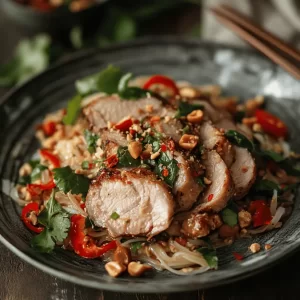
Thai Peanut Pork Tenderloin with Rice Vermicelli Noodles
This Thai Peanut Pork Tenderloin recipe features tender, marinated pork served over rice vermicelli noodles with a creamy, slightly spicy peanut sauce and fresh herbs. It’s a flavorful, easy-to-make dish that’s perfect for both weeknight dinners and special occasions.
Ingredients
For The Pork
- 2 tbsp soy sauce
- 1 tbsp fish sauce
- 2 tbsp lime juice
- 1 tbsp honey
- 1 tbsp sesame oil
- 2 tsp The Spice Girl Kitchen Thai Seasoning
- 1 lb pork tenderloin
- 1 tbsp coconut oil, for searing
For The Peanut Sauce
- 1/3 cup creamy peanut butter
- 2 tbsp soy sauce
- 1 tbsp fish sauce
- 1 tbsp rice vinegar
- 2 tbsp lime juice
- 2 tsp sriracha or chili garlic sauce
- 2 tsp honey
- 1 tsp The Spice Girl Kitchen Thai Seasoning
- 1/4 cup coconut milk
For The Noodles
- 8 oz vermicelli noodles (or glass noodles)
- 1 tbsp sesame oil
- 1 red bell pepper, thinly sliced
- 1/2 red onion, thinly sliced
- 1/4 cup fresh cilantro
- 1/4 cup fresh basil
- 1/4 cup roasted peanuts, chopped
- 1-2 red chilies, thinly sliced (optional)
Instructions
Marinate the Pork
- In a bowl, combine soy sauce, fish sauce, lime juice, honey, sesame oil, and Thai seasoning.
- Place the pork tenderloin in a resealable plastic bag or shallow dish and pour the marinade over it. Let it marinate in the fridge for at least 30 minutes (up to 4 hours for more flavor).
Cook the Pork
- Preheat your oven to 400°F.
- Heat coconut oil in a large oven-safe skillet over medium-high heat. Sear the marinated pork on all sides until golden brown, about 2-3 minutes per side.
- Transfer the skillet to the oven and roast the pork for 15-20 minutes, or until the internal temperature reaches 145°F. Let the pork rest for 5 minutes before slicing.
Prepare the Peanut Sauce & Noodles
- While the pork is cooking, whisk together the peanut butter, soy sauce, fish sauce, rice vinegar, lime juice, sriracha, honey, Thai spice, and coconut milk in a small bowl until smooth. Adjust consistency by adding more liquid if needed.
- Cook the rice vermicelli noodles according to package instructions. Drain and toss with sesame oil to prevent sticking.
Assemble & Serve
- In a large mixing bowl, toss the cooked noodles with the red bell pepper, red onion, fresh cilantro, and basil/mint leaves. Drizzle half of the peanut sauce over the noodle mixture and toss to coat.
- Divide the noodles among serving plates. Arrange the sliced pork tenderloin on top of the noodles. Drizzle more peanut sauce over the pork. Garnish with chopped peanuts, sliced red chilies, lime wedges, and additional cilantro if desired.